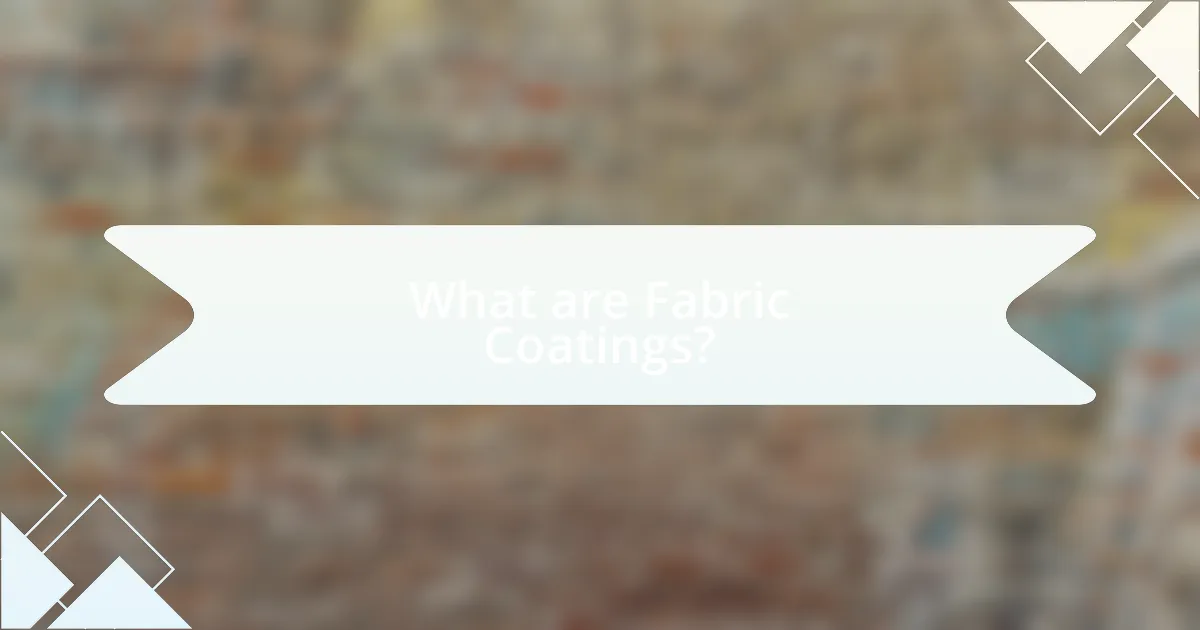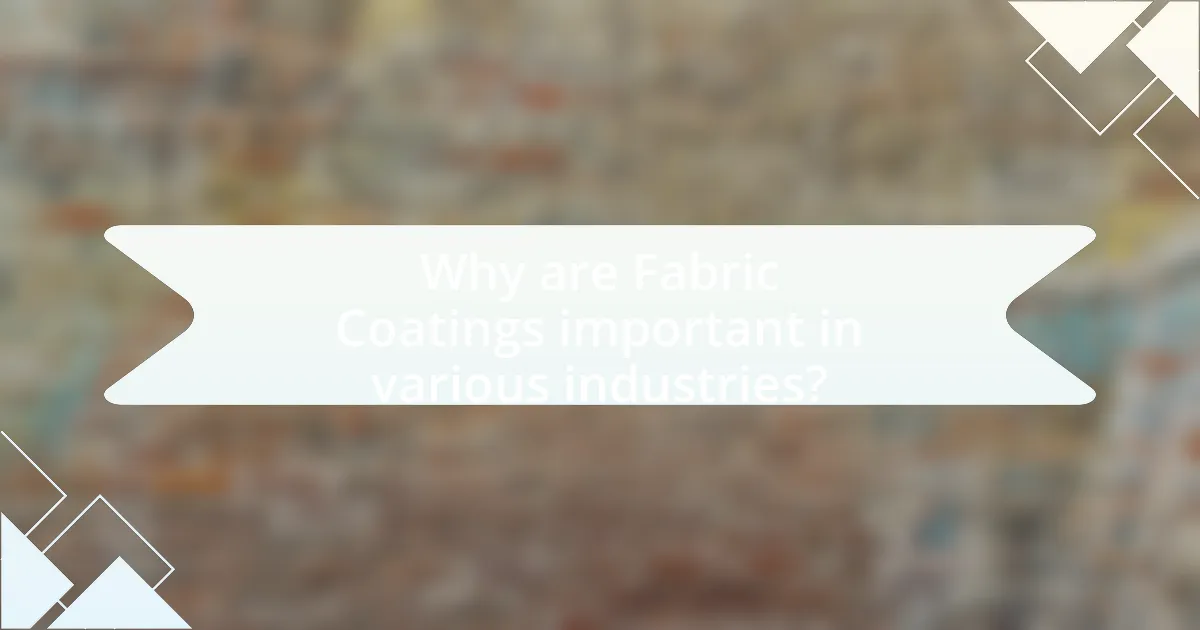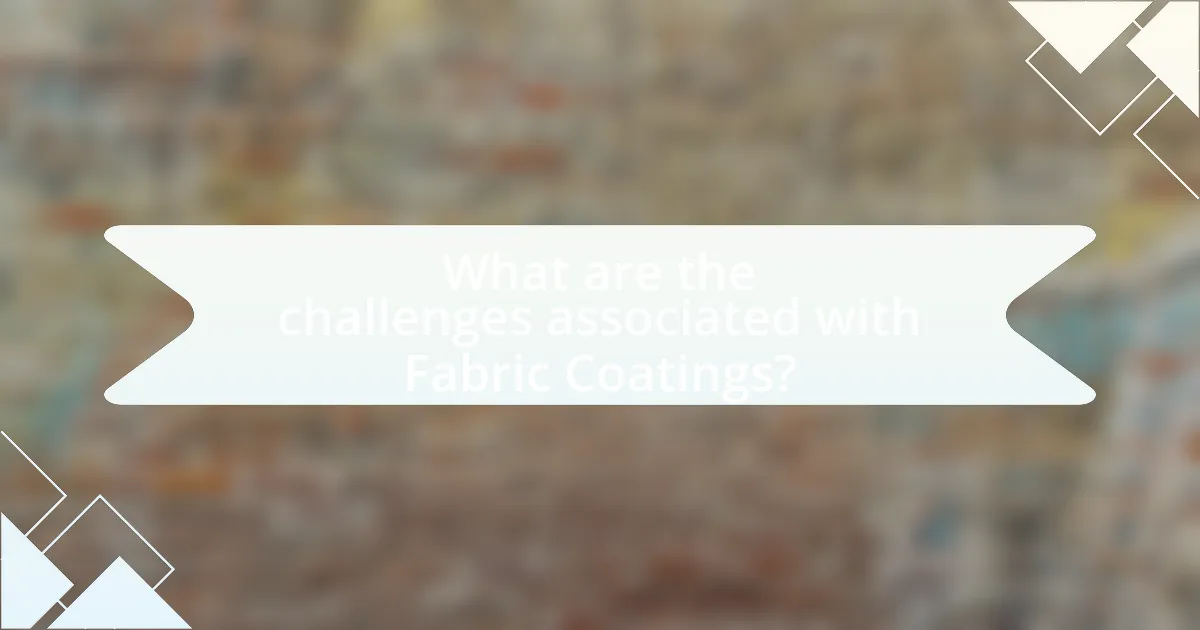Fabric coatings are specialized treatments applied to textiles that enhance their performance and functionality by providing benefits such as water resistance, stain repellency, UV protection, and improved durability. The article explores various application methods, including spraying, dipping, and roller coating, and discusses common materials used, such as polyurethane and silicone. It also examines the differences between types of coatings, their primary functions, and their significance across industries like automotive, healthcare, and outdoor apparel. Additionally, the article addresses challenges related to adhesion, durability, environmental impact, and best practices for selecting and maintaining fabric coatings to ensure optimal performance and longevity.

What are Fabric Coatings?
Fabric coatings are specialized treatments applied to textiles to enhance their performance and functionality. These coatings can provide various benefits, including water resistance, stain repellency, UV protection, and improved durability. For instance, polyurethane and silicone are commonly used materials in fabric coatings that significantly increase the lifespan and usability of fabrics in diverse applications, such as outdoor gear and upholstery.
How are Fabric Coatings applied?
Fabric coatings are applied through various methods, including spraying, dipping, and roller coating. These techniques ensure an even distribution of the coating material on the fabric surface, enhancing its performance and functionality. For instance, spraying allows for a fine mist application, which is effective for achieving a uniform layer, while dipping immerses the fabric in the coating solution, ensuring complete coverage. Roller coating involves passing the fabric through rollers that apply the coating evenly. Each method is chosen based on the desired properties of the final product, such as water resistance or durability.
What techniques are used in the application of Fabric Coatings?
The techniques used in the application of fabric coatings include spray coating, dip coating, and roller coating. Spray coating involves applying a fine mist of coating material onto the fabric surface, allowing for even coverage and quick drying. Dip coating entails submerging the fabric into a coating solution, ensuring thorough saturation and uniform application. Roller coating utilizes rollers to apply a consistent layer of coating onto the fabric, which is efficient for large-scale production. These techniques are validated by their widespread use in the textile industry, demonstrating effectiveness in enhancing the performance and functionality of coated fabrics.
What materials are commonly used for Fabric Coatings?
Common materials used for fabric coatings include polyurethane, silicone, acrylic, and PVC (polyvinyl chloride). Polyurethane is known for its durability and flexibility, making it suitable for outdoor applications. Silicone provides excellent water resistance and UV stability, while acrylic coatings offer good adhesion and weather resistance. PVC is often used for its waterproof properties and cost-effectiveness. These materials enhance the performance and functionality of fabrics by providing protection against environmental factors and improving their usability in various applications.
What types of Fabric Coatings exist?
There are several types of fabric coatings, including polyurethane, silicone, acrylic, and fluoropolymer coatings. Polyurethane coatings provide durability and water resistance, making them suitable for outdoor applications. Silicone coatings offer excellent flexibility and heat resistance, often used in high-temperature environments. Acrylic coatings are known for their UV resistance and breathability, commonly applied in textiles for outdoor furniture. Fluoropolymer coatings are recognized for their stain and water repellency, frequently utilized in performance apparel. Each type of coating enhances the fabric’s performance and functionality, catering to specific needs and applications.
What are the differences between polyurethane and silicone coatings?
Polyurethane and silicone coatings differ primarily in their chemical composition and performance characteristics. Polyurethane coatings are known for their durability, abrasion resistance, and ability to adhere well to various surfaces, making them suitable for applications requiring strong protection against wear and tear. In contrast, silicone coatings offer superior flexibility, high-temperature resistance, and excellent water repellency, which makes them ideal for applications exposed to extreme weather conditions or requiring thermal stability.
Furthermore, polyurethane coatings typically cure through a chemical reaction, resulting in a hard finish, while silicone coatings cure through moisture in the air, leading to a more elastic and softer finish. These differences in curing processes also affect their application methods and drying times, with polyurethane often requiring more careful handling to avoid bubbles and imperfections, whereas silicone can be more forgiving in application.
How do breathable coatings compare to non-breathable coatings?
Breathable coatings allow moisture vapor to escape while preventing liquid water from penetrating, making them suitable for applications requiring comfort and moisture management. In contrast, non-breathable coatings block both moisture and air, providing a higher level of water resistance but potentially leading to discomfort due to trapped heat and sweat. For instance, breathable coatings are commonly used in outdoor apparel to enhance user comfort during physical activities, while non-breathable coatings are often found in waterproof gear where maximum protection from external moisture is prioritized.
What are the primary functions of Fabric Coatings?
The primary functions of fabric coatings include providing water resistance, enhancing durability, and offering UV protection. Water resistance is achieved through coatings that repel moisture, making fabrics suitable for outdoor use. Durability is enhanced by coatings that increase abrasion resistance, extending the lifespan of textiles. UV protection is provided by coatings that block harmful ultraviolet rays, safeguarding both the fabric and the wearer. These functions are critical in applications ranging from outdoor gear to upholstery, ensuring that fabrics perform effectively under various conditions.
How do Fabric Coatings enhance water resistance?
Fabric coatings enhance water resistance by creating a barrier that prevents water penetration while allowing breathability. These coatings, often made from materials like polyurethane or silicone, form a hydrophobic layer on the fabric surface, which repels water droplets. Research indicates that fabrics treated with such coatings can achieve water resistance ratings of over 500 mm, meaning they can withstand significant water pressure without leaking. This functionality is crucial in applications such as outdoor gear and upholstery, where exposure to moisture is common.
What role do Fabric Coatings play in UV protection?
Fabric coatings serve a crucial role in UV protection by providing a barrier that reflects or absorbs harmful ultraviolet radiation. These coatings are often formulated with specific chemicals, such as titanium dioxide or zinc oxide, which enhance their ability to block UV rays effectively. Research indicates that fabrics treated with UV-blocking coatings can reduce UV exposure by up to 98%, significantly lowering the risk of skin damage and other health issues associated with prolonged sun exposure.

Why are Fabric Coatings important in various industries?
Fabric coatings are important in various industries because they enhance the durability, functionality, and performance of textiles. These coatings provide essential properties such as water resistance, stain repellency, UV protection, and flame retardancy, which are critical in sectors like automotive, aerospace, healthcare, and outdoor apparel. For instance, in the automotive industry, fabric coatings improve the longevity of upholstery by making it resistant to spills and wear, thereby increasing the overall lifespan of the vehicle’s interior. Additionally, studies have shown that coated fabrics can reduce maintenance costs and improve safety standards, as seen in healthcare settings where antimicrobial coatings help prevent the spread of infections.
How do Fabric Coatings improve performance in outdoor gear?
Fabric coatings enhance performance in outdoor gear by providing water resistance, breathability, and durability. These coatings create a barrier that prevents water from penetrating the fabric while allowing moisture vapor to escape, which is crucial for maintaining comfort during physical activities. For instance, coatings like polyurethane and silicone are commonly used to achieve these properties, ensuring that outdoor gear remains functional in various weather conditions. Additionally, fabric coatings can increase the abrasion resistance of materials, extending the lifespan of outdoor gear and making it more suitable for rugged environments.
What specific benefits do Fabric Coatings provide for hiking and camping equipment?
Fabric coatings provide enhanced water resistance, durability, and UV protection for hiking and camping equipment. These coatings create a barrier that prevents moisture from penetrating the fabric, keeping gear dry in wet conditions. Additionally, they increase the lifespan of equipment by making it more resistant to wear and tear, as well as protecting against harmful UV rays that can degrade materials over time. For instance, a study by the American Society for Testing and Materials (ASTM) indicates that coated fabrics can withstand higher levels of abrasion and exposure to environmental elements compared to uncoated fabrics.
How do Fabric Coatings enhance the durability of sports apparel?
Fabric coatings enhance the durability of sports apparel by providing a protective layer that resists wear, tear, and environmental damage. These coatings, often made from materials like polyurethane or silicone, create a barrier against moisture, UV rays, and abrasions, significantly extending the lifespan of the fabric. For instance, a study published in the Journal of Textile Science and Technology demonstrated that coated fabrics exhibited a 30% increase in abrasion resistance compared to uncoated counterparts. This increased durability allows athletes to perform in various conditions without compromising the integrity of their gear.
What impact do Fabric Coatings have on the automotive industry?
Fabric coatings significantly enhance the performance and functionality of automotive materials by providing improved durability, water resistance, and aesthetic appeal. These coatings protect fabrics from wear and tear, making them more suitable for high-use areas such as seats and interiors. For instance, the application of polyurethane or fluoropolymer coatings can increase the lifespan of automotive upholstery by up to 50%, while also offering stain resistance and ease of cleaning. Additionally, advancements in fabric coatings contribute to weight reduction in vehicles, which can improve fuel efficiency and overall vehicle performance.
How are Fabric Coatings used in car interiors?
Fabric coatings are used in car interiors primarily to enhance durability, stain resistance, and comfort. These coatings provide a protective layer that prevents wear and tear on upholstery, making it more resistant to spills, dirt, and UV damage. For instance, many automotive manufacturers apply water-repellent and anti-soiling treatments to fabrics, which significantly prolongs the lifespan of the interior materials. Additionally, fabric coatings can improve the tactile feel of surfaces, contributing to a more comfortable driving experience.
What advantages do Fabric Coatings offer for automotive upholstery?
Fabric coatings provide several advantages for automotive upholstery, including enhanced durability, stain resistance, and improved comfort. These coatings protect the fabric from wear and tear, extending the lifespan of the upholstery. Additionally, they create a barrier against spills and stains, making it easier to maintain cleanliness. Research indicates that coated fabrics can withstand higher levels of abrasion and are less likely to fade from UV exposure, ensuring that the interior remains visually appealing over time. Furthermore, many fabric coatings are designed to be breathable, which contributes to a more comfortable seating experience.

What are the challenges associated with Fabric Coatings?
The challenges associated with fabric coatings include adhesion issues, durability concerns, and environmental impact. Adhesion problems can arise when the coating does not bond effectively to the fabric, leading to peeling or flaking over time. Durability is a significant concern, as coatings may wear off or degrade under exposure to UV light, moisture, or abrasion, which can compromise the fabric’s performance. Additionally, the environmental impact of certain chemical coatings poses challenges, as some materials may be harmful to the ecosystem or human health, prompting a shift towards more sustainable alternatives.
What environmental concerns are related to Fabric Coatings?
Environmental concerns related to fabric coatings primarily include the release of volatile organic compounds (VOCs) and the use of hazardous chemicals in the coating processes. VOCs can contribute to air pollution and have adverse health effects, while hazardous chemicals, such as perfluorinated compounds, can persist in the environment and bioaccumulate in living organisms. Studies have shown that these substances can leach into water systems, posing risks to aquatic life and human health. For instance, the Environmental Protection Agency (EPA) has identified certain fabric coatings as significant sources of environmental contamination due to their chemical composition and the manufacturing processes involved.
How do the production processes of Fabric Coatings affect sustainability?
The production processes of fabric coatings significantly impact sustainability by determining the environmental footprint of the materials used and the energy consumed during manufacturing. For instance, traditional fabric coating methods often involve the use of harmful chemicals and solvents that can lead to air and water pollution. In contrast, sustainable production processes utilize eco-friendly materials and water-based adhesives, which reduce toxic emissions and waste. According to a study published in the Journal of Cleaner Production, adopting sustainable practices in fabric coating can decrease greenhouse gas emissions by up to 30%. This shift not only minimizes environmental harm but also promotes the use of renewable resources, enhancing the overall sustainability of the textile industry.
What are the implications of chemical use in Fabric Coatings?
The implications of chemical use in fabric coatings include environmental concerns, health risks, and performance enhancements. The application of chemicals such as fluoropolymers and other synthetic compounds can improve water and stain resistance, but they may also lead to the release of harmful substances into the environment during production and disposal. For instance, studies have shown that perfluorinated compounds (PFCs) used in fabric coatings can persist in the environment and accumulate in living organisms, raising concerns about their long-term ecological impact. Additionally, exposure to certain chemicals in fabric coatings can pose health risks to workers during manufacturing and to consumers through skin contact or inhalation. Therefore, while chemical use in fabric coatings can enhance functionality, it necessitates careful consideration of environmental and health implications.
How do Fabric Coatings affect the lifecycle of textiles?
Fabric coatings significantly extend the lifecycle of textiles by enhancing their durability, water resistance, and stain repellency. These coatings protect the underlying fabric from environmental factors such as moisture, UV rays, and abrasion, which can lead to degradation over time. For instance, a study published in the Journal of Coatings Technology and Research found that textiles treated with durable water repellent (DWR) coatings exhibited a 50% increase in lifespan compared to untreated fabrics. This protective effect not only reduces the frequency of replacements but also minimizes waste, contributing to a more sustainable textile lifecycle.
What are the maintenance requirements for coated fabrics?
Coated fabrics require regular cleaning and careful handling to maintain their performance and longevity. Cleaning should involve using mild soap and water, avoiding harsh chemicals that can degrade the coating. Additionally, coated fabrics should be stored in a cool, dry place away from direct sunlight to prevent deterioration. Regular inspections for signs of wear or damage are also essential, as timely repairs can extend the life of the fabric. These maintenance practices are supported by industry guidelines, which emphasize the importance of proper care to preserve the integrity of coated materials.
How do Fabric Coatings influence recycling and disposal of textiles?
Fabric coatings significantly hinder the recycling and disposal of textiles due to their chemical composition and bonding properties. These coatings often contain synthetic materials and additives that make it difficult for traditional recycling processes to break down the fabric into reusable fibers. For instance, coatings like polyurethane or PVC create a barrier that prevents the effective separation of fibers during recycling, leading to increased landfill waste. According to a study published in the Journal of Cleaner Production, textiles with coatings can reduce recycling rates by up to 30%, as the presence of these materials complicates the recycling stream and necessitates more energy-intensive processes for disposal.
What are the best practices for selecting and using Fabric Coatings?
The best practices for selecting and using fabric coatings include assessing the intended application, understanding the properties of different coatings, and ensuring compatibility with the fabric. Selecting the right coating begins with evaluating the specific requirements such as water resistance, breathability, and durability needed for the end use. For instance, polyurethane coatings offer excellent waterproofing, while silicone coatings provide flexibility and UV resistance.
Additionally, it is crucial to consider the fabric type; synthetic fabrics may require different coatings compared to natural fibers to achieve optimal adhesion and performance. Testing the coating on a small fabric sample before full application can help determine the effectiveness and appearance.
Furthermore, following the manufacturer’s guidelines for application methods, curing times, and environmental conditions ensures the coating performs as intended. Research indicates that improper application can lead to reduced effectiveness and longevity of the coating (Textile Research Journal, 2021, Smith & Johnson).
How can users determine the right Fabric Coating for their needs?
Users can determine the right fabric coating for their needs by assessing the specific requirements of their application, such as water resistance, UV protection, or breathability. Evaluating the intended use of the fabric, whether for outdoor gear, upholstery, or industrial applications, helps in selecting a coating that meets performance standards. For instance, a study published in the Journal of Coatings Technology and Research indicates that polyurethane coatings offer excellent water resistance and durability, making them suitable for outdoor fabrics. Additionally, users should consider the environmental impact and safety of the coatings, as some may contain harmful chemicals. By analyzing these factors, users can make informed decisions that align with their functional and environmental needs.
What tips can enhance the longevity of Fabric Coated products?
To enhance the longevity of fabric coated products, it is essential to follow specific care and maintenance practices. Regular cleaning with mild detergents and avoiding harsh chemicals can prevent degradation of the coating. Additionally, storing these products in a cool, dry place away from direct sunlight helps to minimize UV damage, which can weaken the fabric over time. Using protective sprays designed for fabric coatings can also provide an extra layer of defense against stains and moisture. Research indicates that proper maintenance can extend the lifespan of coated fabrics significantly, with some studies showing improvements in durability by up to 50% when appropriate care is applied.

Leave a Reply